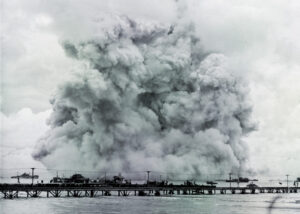A Floating Revolution
The steam-powered ironclad Monitor was a revolutionary weapon. Designed and built by Swedish-born engineer John Ericsson, the ironclad was a bizarre prototype that featured dozens of original inventions. Nicknamed the “cheesebox on a raft” because of her round two-gun turret mounted on a low, flat hull, the Monitor was the first warship with a revolving turret. It would change the shape of naval warfare forever.
The Monitor’s turret, encased in thick iron armor, was turned by a small steam engine. The turret’s ability to revolve gave the guns a 360-degree sweep, enabling the crew to fire on any target within range without maneuvering the vessel. The guns–two 11-inch smoothbore Dahlgrens–sat side by side in the turret, their muzzles aligned with two corresponding gunports in the turret wall. Iron shutters covered the gunports when the guns were not firing, at least in theory; in actual combat, the crew generally left the shutters open and turned the turret to protect themselves while they loaded the guns.
The Monitor was built in response to reports that the Confederacy was constructing a steam-powered ironclad gunship on the partially burned hull of the U.S.S. Merrimac, a screw frigate that was seized when Confederates captured the Gosport Navy Yard in Norfolk, Virginia. The Confederate ship, rechristened C.S.S. Virginia, had armored casemates, but they were immovable. Just five weeks after the Monitor was launched, the two ironclads would meet in combat.
On March 8, 1862, the 10-gun Virginia emerged from the Elizabeth River and destroyed the 24-gun U.S.S. Cumberland and the 50-gun U.S.S. Congress–both wooden vessels–near Newport News Point (Camp Butler). The U.S.S. Minnesota ran aground farther to the east. At sunset, the Virginia retired to Sewell’s Point, intending to finish off the Minnesota the next day.
The Monitor was on her way, having left New York Harbor under tow on March 4, 1862. Though she nearly sank along the way, the Union ironclad arrived at Cape Henry on March 8–the day the Virginia went on her rampage against the wooden Federal warships. The next morning, the Monitor was in position near the Minnesota and ready for action.
The Battle of Hampton Roads, as the fight between the ironclads became known, raged about three miles south-southwest of Fort Monroe and a mile north-northeast of Sewell’s Point. The two ships pounded away at each other for four hours before first the Monitor and then the Virginia retired, having done little damage to each other. The battle ended in a draw, although the Monitor had saved the rest of the Northern ships. The two ironclads never fought again, but the fight signaled the end of the era of wooden warships.
The Virginia was destroyed by her own crew near Craney Island on May 11 when Confederate forces evacuated Norfolk and Portsmouth. The Monitor played a small role in the Battle of Drewry’s Bluff on the James River on May 15, between Federal ships and Confederate shore batteries. Near the end of December 1862 the Monitor was ordered to Beaufort, North Carolina, for blockade duty, and ran into a severe storm. “The Graveyard of the Atlantic” off Cape Hatteras became her final resting place.
Bert Hubinger




